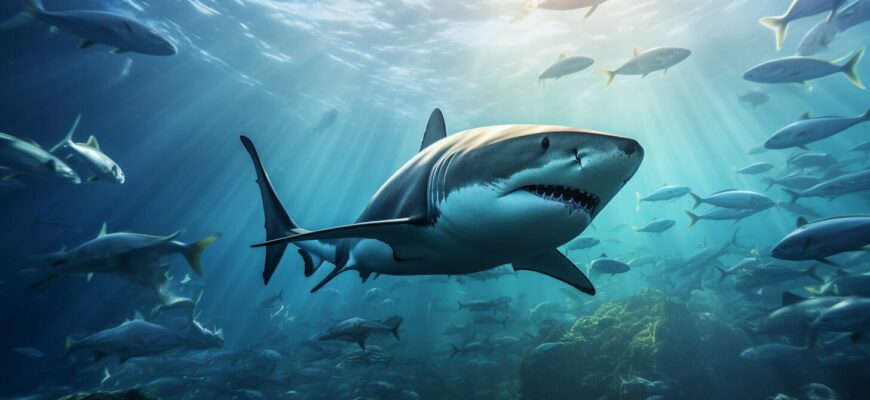Welcome to the intriguing world of sharks and their swimming abilities! Sharks are fascinating creatures that have captured our attention for eons. Their sleek and agile bodies have helped them become some of the most efficient swimmers in the animal kingdom. However, have you ever wondered how they fare in shallow waters?
Understanding shark behavior and their habitat is crucial, particularly in areas where humans and sharks frequently encounter one another. In this article, we will be exploring how shallow sharks can swim and the various factors that influence their behavior in shallow waters.
- The Basics of Shark Swimming
- The role of body shape and size
- Adaptations for swimming in different depths
- Shallow-Water Sharks: Exploring the Shallows
- How Shallow is “Shallow” for Sharks?
- Navigating the Shallows: Shark Senses at Play
- Sharks and Human Encounters in Shallow Waters
- FAQs about Sharks in Shallow Waters
- Are shark attacks common in shallow waters?
- What should I do if I see a shark while swimming in shallow waters?
- What types of sharks are commonly found in shallow waters?
- How deep is considered “shallow” for sharks?
- What can we do to help protect sharks in shallow waters?
The Basics of Shark Swimming
Sharks are well-known for their expert swimming abilities. Their streamlined bodies and strong muscles enable them to move effortlessly through the water.
Most species of sharks swim continuously to breathe, and their swimming behavior varies depending on their habitats and the availability of prey. Some species, such as the great white shark, are known for their high-speed bursts of swimming, while others, such as nurse sharks, tend to glide along the ocean floor.
The role of body shape and size
The body shape and size of a shark are crucial factors in their swimming behavior. For instance, larger species like the whale shark have a more buoyant body and a slower swimming speed, while smaller species like the blue shark have a sleeker body design, which enables them to swim faster.
Their long, curved tails also play a vital role in their swimming behavior, allowing them to change direction rapidly and maintain their speed.
Adaptations for swimming in different depths
Sharks are found in different depths of the ocean, and each species is uniquely adapted to its environment. For instance, bottom dwellers like the nurse shark have adapted to their habitat by developing a flattened head and body, which makes it easier for them to navigate the ocean floor.
Other sharks like the great white and tiger shark prefer open water and have streamlined bodies, which enable them to swim faster and more efficiently through deep waters.
In contrast, shallow-water sharks like the blacktip reef shark are agile swimmers and have adapted their behavior to swim closer to the surface and in shallow water with ease.
Sharks are fascinating creatures with unique swimming behavior and adaptations that help them thrive in different depths and habitats. Understanding their swimming behavior and characteristics is essential, not only for our curiosity but also for conservation efforts and ensuring safe human-shark encounters.
Shallow-Water Sharks: Exploring the Shallows
Sharks are known to inhabit a variety of aquatic environments, from the deep sea to shallow waters. Shallow-water sharks, in particular, are those species that tend to inhabit waters less than 200ft deep. These sharks are often seen close to shorelines, making them more visible and accessible to humans.
There are several species of shallow-water sharks that are commonly found in coastal waters around the world. One example is the blacktip shark, a species that prefers to swim in shallow, warm waters. Another is the nurse shark, which is known for its docile behavior and is often found resting on the seafloor in shallow waters.
Shallow-water sharks have adapted to their habitat in several ways. For example, their bodies tend to be more slender and agile than those of deep-sea sharks, allowing them to navigate through shallow waters more easily. They also tend to have specialized fins that enable them to maneuver in tight spaces and make quick turns.
| Common Shallow-Water Sharks | Preferred Habitat | Diet |
|---|---|---|
| Blacktip Shark | Shallow, warm waters | Fish, crustaceans, squid |
| Nurse Shark | Shallow, sandy areas near coral reefs | Crustaceans, mollusks, fish |
| Hammerhead Shark | Coastal waters, rocky reefs | Fish, squid, octopuses |
Although shallow-water sharks are generally not considered a threat to humans, it is important to be aware of their presence when swimming or diving in their habitat. Sharks, like all wild animals, can be unpredictable and may become aggressive if they feel threatened or provoked.
Furthermore, human activities such as pollution and overfishing can have a significant impact on the populations of shallow-water sharks and their habitat. As such, it is important to promote conservation efforts and sustainable practices to protect these important marine predators and their environment.
How Shallow is “Shallow” for Sharks?
The depth at which sharks are considered to be in shallow waters varies depending on the species and their habitats. For example, some coastal species of sharks, such as the blacktip and lemon shark, can be found in waters as shallow as 3 feet (1 meter). On the other hand, deep sea species like the goblin shark are rarely found in waters shallower than 330 feet (100 meters).
Factors such as water temperature, prey availability, and geography also play an important role in determining shark habitat. For instance, shallow waters with high temperatures provide optimal breeding and feeding environments for some species of shark, while others prefer cooler water temperatures. Certain species, such as the great white shark, are known to migrate to coastal areas in search of seals and sea lions as a source of food.
| Species | Shallow Water Depth Range |
|---|---|
| Blacktip Shark | 3-30 feet (1-9 meters) |
| Lemon Shark | 3-30 feet (1-9 meters) |
| Tiger Shark | 3-100 feet (1-30 meters) |
| Hammerhead Shark | 3-200 feet (1-60 meters) |
| Bull Shark | 3-210 feet (1-64 meters) |
It’s important to note that even in shallow waters, sharks can still pose a potential risk to humans. It’s always best to be cautious and informed about shark behavior and safety tips when spending time in their habitat.
Navigating the Shallows: Shark Senses at Play
Sharks have a remarkable sensory system that helps them navigate the shallow waters with ease. Their keen sense of smell, electroreception, and lateral line system work together to detect prey and avoid obstacles, making them efficient hunters in their habitat.
The sense of smell is particularly crucial for sharks in shallow waters. They can detect a single drop of blood from miles away, enabling them to pinpoint potential prey. This ability also helps them navigate towards shorelines during mating and breeding seasons.
Electroreception is another remarkable sensory ability that sharks possess. They can detect the weak electrical signals given off by other living organisms, which includes prey items. This ability allows them to locate prey even when they are hidden from sight.
The lateral line system is another sensory mechanism that sharks possess. It helps them detect vibrations and movements in the surrounding water, allowing them to sense and avoid obstacles in their path.
Together, these sensory abilities make sharks adept at navigating the shallow waters and locate their prey. However, it is important to note that human activities, such as excessive noise pollution, can disrupt their sensory abilities and affect their behavior.
As such, it is important to respect their habitat and take necessary precautions to avoid disturbing them.
Sharks and Human Encounters in Shallow Waters
Human-shark encounters in shallow waters can be a cause for concern, but they are relatively rare. However, it’s important to take precautions and follow safety tips to minimize the risk of a negative encounter.
Here are some important safety tips:
- Never swim alone, and always stay in groups.
- Do not enter the water if you have an open wound, as sharks are attracted to the smell of blood.
- Avoid swimming at dawn and dusk when sharks are more active.
- Do not wear shiny jewelry or brightly colored clothing, as it can attract sharks.
- Stay away from schools of fish, as sharks may be feeding in the area.
- Do not harass or provoke sharks.
- If you spot a shark, remain calm and slowly and quietly back away from it. Do not panic or attempt to swim away quickly.
It’s important to recognize that sharks are an essential part of our ocean ecosystem and play a vital role in maintaining a healthy balance. By respecting their habitat and following safety guidelines, we can minimize the risk of negative encounters and continue to enjoy the beauty and wonder of our oceans.
FAQs about Sharks in Shallow Waters
Here are some frequently asked questions related to sharks in shallow waters:
Are shark attacks common in shallow waters?
While shark attacks can happen anywhere, they are not very common in shallow waters where beachgoers typically swim. Most shark attacks occur in deeper waters and are often a case of mistaken identity.
What should I do if I see a shark while swimming in shallow waters?
If you see a shark, remain calm and slowly and steadily move back towards shore. Avoid sudden movements or splashing as these can attract the shark. Keep your eyes on the shark at all times and do not turn your back on it.
What types of sharks are commonly found in shallow waters?
Species such as blacktip sharks, lemon sharks, and reef sharks are commonly found in shallow waters near shorelines and coral reefs. These sharks are typically not interested in humans and are more focused on hunting for small fish and other prey.
How deep is considered “shallow” for sharks?
The depth that is considered shallow for sharks can vary depending on the species and location. Some species such as reef sharks can be found in waters as shallow as two feet, while others such as great white sharks tend to stay in deeper waters.
What can we do to help protect sharks in shallow waters?
The best way to protect sharks in shallow waters is to respect their habitat and avoid disruptive activities such as shark feeding or chumming. Educating others about the importance of sharks in the ecosystem can also go a long way in promoting their conservation.









